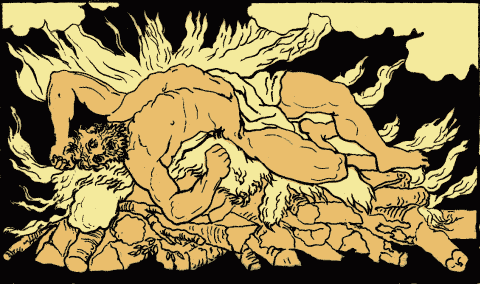Roman Killing Theatre August 5, 2014
Author: Beach Combing | in : Ancient , trackbackThe Romans, as is well known, had a particular genius for killing and for all their precious disgust at human sacrifice (the Empire banned human sacrifice wherever they found it) gladiatorial displays, occasional acts of genocide and public executions were all to the good. The most unusual aspect of Roman public executions was the willingness to turn them into a game. This must be understood correctly. This was not an execution game as in 1980s fantasy where if you find your way out of Death Dungeon you get to survive. It was a game in the sense that you, the criminal, were killed in a theatrically entertaining way, where you were expected to play a role. These theatrical acts traditionally took place in the ampitheatre at midday between the morning and the afternoon’s fighting. Examples:
30 BC- 40 BC (?): Strabo records a Sicilian bandit king Selurus, who was placed on a wooden imitation of Mount Etna, built above a cage of wild animals: the mountain was made, at a given signal to collapse, and Selurus fell through into the cage where he was torn apart.
Mid First Century AD: a criminal named Meniscus was burnt alive in imitation of Hercules (see image above): Meniscus was likely dressed and perhaps made to act as Hercules.
Mid late first century: Martial describes a criminal plunging his hand into the fire voluntarily, in imitation of Mucius Scaevola, apparently because had he not he would have been burnt entirely.
80 AD (?): a criminal was made to dress like Orpheus and play the lyre to wild animals. He was torn apart.
80 AD (?): a ‘Daedelus’ was dropped among bears: presumably he was flown into the area on a wire and then the wings ‘broke’. Lest this seem incredible there is a record of a Daedelus (also a criminal?) falling next to Nero in the ampitheatre and splattering the Emperor with blood, a generation before.
80 AD (?): ‘Pasiphae’ (a woman criminal?) coupled with a bull, like her mythological counterpart. If she survived the experience she will have been killed afterwards? (This echoes a memorable scene in Apuleius)
Late Second Century AD: Tertullian records criminals being dressed up as Attis, the castrated god: they were, we might imagine, publicly castrated; others dressed as Hercules were incinerated.
Late Second Century AD: Clement of Rome describes Christian women being dressed as Danaids and Dirce: Dirce was, in myth, tied to the horns of a bull, so no question how that ended…
c. 200 AD: Perpetua, the Christian martyr was to have dressed up in mythological costume: but she refused to cooperate and was tied up and brought out nude into the arena.
These sources are all, in one way or another, inadequate: epigrams, asides, partisan polemic… We have no ‘journalistic’ description of criminals being done away with in this fashion. But enough imperfect sources add up to fact. Perhaps there is only one question left: how did the Roman authorities get those condemned to death to play along? The first point is that many did not need ‘to play along’. For example, poor old Selurus on top of his collapsing mountain could have been restrained and the display would still have excited the audience who came to see him die; ditto a woman bound to a platform while a bull trotted into the arena. Second, in some cases there may have been a sense that by playing along a criminal avoided death or at least a worst death. There is a strong hint of this in the case of ‘Mucius Scaevola’ who seems to have burnt his hand so as not to be burnt to death: did this mean that he was given a merciful death, or that he was then released entirely? Likewise the ‘Orpheus’ who played to the animals may have been informed that should none attack him, then he would have been released or killed in a more humane way. (Lest all this seems to be too good to be true, the executioners could easily have lied…) Third, the organizers may have been able to offer, in return for cooperation, drugs to dull pain: or poison? Fourth, there is a long attested and altogether peculiar bond formed between executioner and executed: perhaps the prisoner saw cooperation as part of a pact between killed and killer in the interests of ‘a good execution’.
Other examples of theatrical deaths from other cultures: drbeachcombing AT yahoo DOT com… Maybe Meso-America?
This post is based almost entirely on a paper I first enjoyed many years ago Kathleen Coleman ‘Fatal Charades: Roman Executions Staged as Mythological Enactments’, Journal of Roman Studies 80 (1990), 44-73, and one that was even more interesting on a reread tonight. Particularly interesting is the way that KC points to how scholars have refused to accept this evidence (even emending away) because it is so unpalatable.



